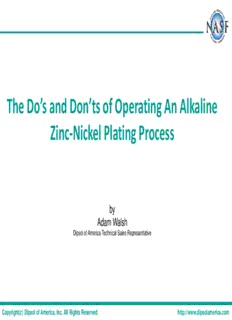
The Do's and Don'ts of Operating An Alkaline Zinc-Nickel Plating Process PDF
Preview The Do's and Don'ts of Operating An Alkaline Zinc-Nickel Plating Process
The Do’s and Don’ts of Operating An Alkaline Zinc-Nickel Plating Process by Adam Walsh Dipsol of America Technical Sales Representative Copyright(c) Dipsol of America, Inc. All Rights Reserved. http://www.dipsolamerica.com Automakers face competition with warranty length • Extending service and functionality timeline Applications are calling for a higher level of corrosion protection • 1000 hours + beyond what typical Zinc finishes can provide Copyright(c) Dipsol of America, Inc. All Rights Reserved. Copyright(c) Dipsol of America, Inc. All Rights Reserved. http://www.dipsolamerica.com Discussion Roadmap: Zn/Ni overview A brief Introduction to Electroplating How Electroplating Works What is Zinc/Nickel Plating? The Benefits of Zn/Ni Alloy Plating The Chemical Components of an Alkaline Zn/Ni bath The Alkaline Electrolyte Solution Zinc, its role in corrosion resistance Nickel’s contribution to the sacrificial coating Nickel Complexer Brightener Copyright(c) Dipsol of America, Inc. All Rights Reserved. http://www.dipsolamerica.com Discussion Roadmap: The Chemistry • The Alkaline Electrolytic Solution Effects of high and low caustic soda • Zinc and Nickel Concentration Metal concentration, appearance, and efficiency • Nickel Complexer Efficiency and Nickel deposit • Brightener Overall appearance and efficiency Copyright(c) Dipsol of America, Inc. All Rights Reserved. http://www.dipsolamerica.com A Brief Introduction to Electroplating Electroplating is the process in which an electric current is used to reduce dissolved metal cations in a plating solution to form a coherent metal coating on a desired electrode. Electroplated Layer 8 – 14 µm Substrate Electroplating changes the chemical, physical, and mechanical properties of the workpiece. • Improved Corrosion Resistance • Outward Appearance Change • Change in Tensile Strength or Surface Hardness Copyright(c) Dipsol of America, Inc. All Rights Reserved. http://www.dipsolamerica.com A Brief Introduction to Electroplating Plating provides protection over steel (Fe) The plated layer is a more active metal on the electro-galvanic scale (corrodes preferentially). • Creates a sacrificial coating Plated Layer Plated Layer Copyright(c) Dipsol of America, Inc. All Rights Reserved. http://www.dipsolamerica.com A Brief Introduction to Electroplating How Electroplating Works The concept of electroplating….. •Passing an electric current through an electrolyte solution •Multiple terminals (electrodes) are dipped into the electrolyte solution – Each electrode is connected to a power supply, completing a circuit – The Positive electrode is known as the Anode – The Negative electrode is known as the Cathode The electrodes and electrolyte solution are made from carefully chosen elements or compounds. Copyright(c) Dipsol of America, Inc. All Rights Reserved. http://www.dipsolamerica.com A Brief Introduction to Electroplating How Electroplating Works When the electricity flows through the circuit…. •Positively charged metal ions in the electrolyte solution are attracted to the negatively charged cathode (workpiece) –The positive metal ions slowly deposit on the cathode, creating the protective outer layer –The speed of the plating deposit largely depends on the current strength and electrolyte concentration Copyright(c) Dipsol of America, Inc. All Rights Reserved. http://www.dipsolamerica.com A Brief Introduction to Electroplating Rack and Barrel Rack Plating Barrel Plating • Large, complex, or fragile parts • Small and durable parts • Kept mostly still during plating – Fasteners and small stampings • Rotating, perforated barrel – Sometimes cathode rockers are used – Uniform finish • Typically faster than barrel • Low cost plating • High part volume Copyright(c) Dipsol of America, Inc. All Rights Reserved. http://www.dipsolamerica.com
Description: